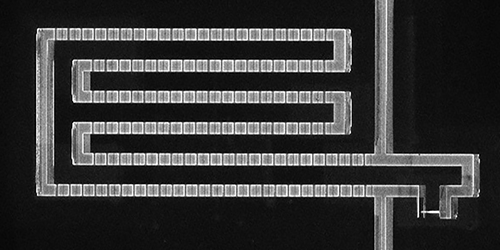Superconducting Qubit Breaks Low-Frequency Record
The most popular qubit for quantum computing—the superconducting transmon—operates at a frequency of several billion hertz (GHz), much like 5G cell phones. This frequency excites transitions between the qubit states that researchers use to control the qubit. Now Samuel Deléglise of Kastler Brossel Laboratory and the National Centre for Scientific Research (CNRS) in France and colleagues have demonstrated a low-frequency transmon alternative that operates at 1.8 million hertz (MHz)—the lowest frequency ever reported for a superconducting qubit [1]. Deléglise notes that a qubit that operates at this frequency could be directly coupled to mechanical resonators based on suspended membranes, which vibrate at a few MHz, to perform tests of macroscopic quantum phenomena.
The team used a so-called fluxonium qubit. Fluxonium qubits have previously been demonstrated, with a record low frequency of 14 MHz achieved in 2021. That qubit consisted of a loop formed of a series of hundreds of Josephson junctions—structures made of two superconductors separated by a thin insulator. The two qubit states corresponded to clockwise and counterclockwise currents flowing in the loop, and the transition frequency was controlled by the strength of a magnetic field threading the loop.
Further lowering the operation frequency of the fluxonium qubit has proved tricky because thermal noise from the environment or noise from magnetic-field fluctuations can easily spoil the qubit’s quantum properties. To solve these problems, the team cooled the qubit with a technique borrowed from cold-atom systems and then tuned the magnetic field so that the qubit states became “Schrödinger-cat” states, which are known to be robust against magnetic-field fluctuations. Using this approach the group was able to achieve a tenfold decrease in the operating frequency of the qubit. In experiments, the team also showed that the qubit could serve as an exceptionally sensitive charge sensor that could pick up tiny quantum fluctuations of a membrane.
–Matteo Rini
Matteo Rini is the Editor of Physics Magazine.
References
- B.-L. Najera-Santos et al., “High-sensitivity ac-charge detection with a MHz-frequency fluxonium qubit,” Phys. Rev. X 14, 011007 (2024).




